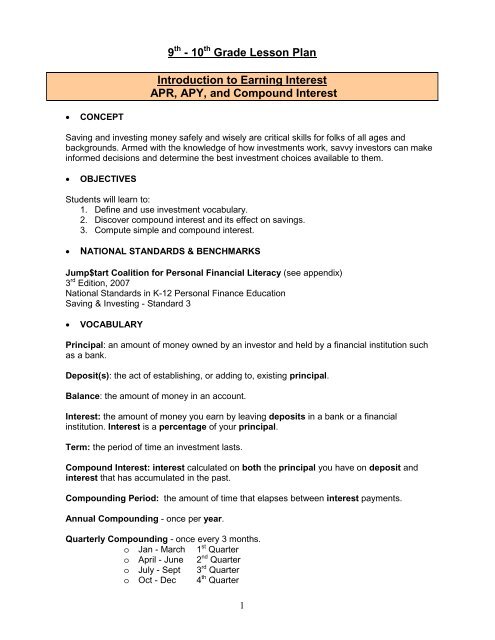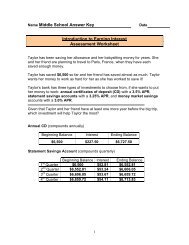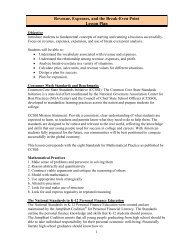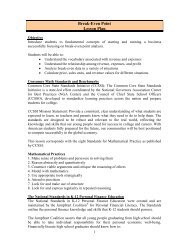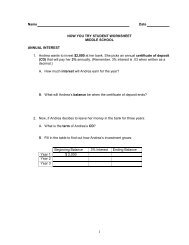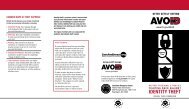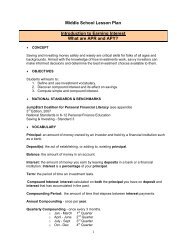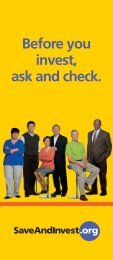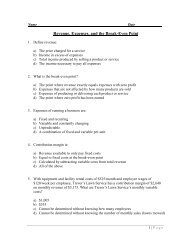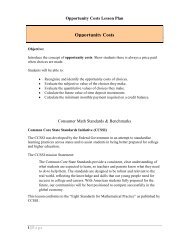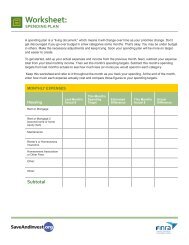Learn More About Compound Interest - SaveAndInvest.org
Learn More About Compound Interest - SaveAndInvest.org
Learn More About Compound Interest - SaveAndInvest.org
Create successful ePaper yourself
Turn your PDF publications into a flip-book with our unique Google optimized e-Paper software.
9 th - 10 th Grade Lesson Plan<br />
Introduction to Earning <strong>Interest</strong><br />
APR, APY, and <strong>Compound</strong> <strong>Interest</strong><br />
• CONCEPT<br />
Saving and investing money safely and wisely are critical skills for folks of all ages and<br />
backgrounds. Armed with the knowledge of how investments work, savvy investors can make<br />
informed decisions and determine the best investment choices available to them.<br />
• OBJECTIVES<br />
Students will learn to:<br />
1. Define and use investment vocabulary.<br />
2. Discover compound interest and its effect on savings.<br />
3. Compute simple and compound interest.<br />
• NATIONAL STANDARDS & BENCHMARKS<br />
Jump$tart Coalition for Personal Financial Literacy (see appendix)<br />
3 rd Edition, 2007<br />
National Standards in K-12 Personal Finance Education<br />
Saving & Investing - Standard 3<br />
• VOCABULARY<br />
Principal: an amount of money owned by an investor and held by a financial institution such<br />
as a bank.<br />
Deposit(s): the act of establishing, or adding to, existing principal.<br />
Balance: the amount of money in an account.<br />
<strong>Interest</strong>: the amount of money you earn by leaving deposits in a bank or a financial<br />
institution. <strong>Interest</strong> is a percentage of your principal.<br />
Term: the period of time an investment lasts.<br />
<strong>Compound</strong> <strong>Interest</strong>: interest calculated on both the principal you have on deposit and<br />
interest that has accumulated in the past.<br />
<strong>Compound</strong>ing Period: the amount of time that elapses between interest payments.<br />
Annual <strong>Compound</strong>ing - once per year.<br />
Quarterly <strong>Compound</strong>ing - once every 3 months.<br />
o Jan - March 1 st Quarter<br />
o April - June 2 nd Quarter<br />
o July - Sept 3 rd Quarter<br />
o Oct - Dec 4 th Quarter<br />
1
Monthly <strong>Compound</strong>ing - once per month.<br />
Annual Percentage Rate (APR): the percentage rate at which interest is calculated annually.<br />
Annual Percentage Yield (APY) - the actual rate your money earns taking compounding into<br />
consideration.<br />
• TEACHING MATERIALS<br />
1. Lesson Plan<br />
2. Teacher Worksheet<br />
3. Now You Try Student Worksheet and Answer Key<br />
4. 9 th - 10 th Grade Assessment Worksheet and Answer Key<br />
• LESSON ACTIVITY<br />
Annual <strong>Compound</strong>ing - Certificate of Deposit<br />
o The teacher will discuss the following vocabulary terms with the students:<br />
principal, deposit, balance, interest, term, and APR. He/She will define an<br />
annual certificate of deposit (which compounds annually) and review Example 1<br />
from the Teacher Worksheet.<br />
o Next, the teacher will discuss the terms compound interest and compounding<br />
period with the students. He/She will review Example 2 from the Teacher<br />
Worksheet.<br />
o The students will practice interest calculations using page 1 from the Now You<br />
Try Student Worksheet.<br />
Quarterly <strong>Compound</strong>ing - Statement Savings Account<br />
o The teacher will discuss quarterly compounding with the students through the<br />
review of the definition and the notes from the Teacher Worksheet. He/She will<br />
explain that statement savings accounts are examples of accounts that often<br />
compound quarterly.<br />
o Next, the teacher will review the pre-calculated example of quarterly interest<br />
payments, Example 3, from the Teacher Worksheet.<br />
• Note: the calculations presented do not take into account that different<br />
months have different numbers of days. Quarterly calculations are done<br />
by computing annual interest then dividing by four.<br />
o Using the Teacher Worksheet, the teacher will compare the interest earned<br />
between the two accounts covered thus far: CDs and statement savings accounts.<br />
• The teacher will explain to the students that annual interest paid<br />
quarterly > annual interest paid annually. He/She will define and<br />
calculate APY.<br />
o The students will practice annual interest calculations using page 2 of the Now<br />
You Try Student Worksheet.<br />
<strong>Compound</strong> <strong>Interest</strong> Formula<br />
o The teacher will introduce the compound interest formula below:<br />
r<br />
A = P( 1+<br />
)<br />
n<br />
nt<br />
Where: A = Accumulated Balance<br />
P = Principal<br />
r = APR expressed as a decimal<br />
n = number of compounding periods/year<br />
t = number of years the investment lasts<br />
2
o<br />
o<br />
Using the quarterly statement savings example, the teacher will practice the<br />
compound interest formula. The values are as follows:<br />
• the formula produces the same accumulated value ($8,161.20);<br />
• the interest calculation is $161.20; and<br />
• the APY is still 2.015%<br />
The students will practice quarterly interest calculations using the compound<br />
interest formula on page 3 of the Now You Try Student Worksheet.<br />
Monthly <strong>Compound</strong>ing - Money Market Account<br />
o The teacher will discuss compounding period and monthly compounding with<br />
the students through the review of the definitions and the notes from the Teacher<br />
Worksheet. He/She will explain that money market savings accounts usually<br />
compound monthly instead of quarterly.<br />
o Next, the teacher will review the pre-calculated example of monthly interest<br />
payments, Example 4, from the Teacher Worksheet.<br />
• Note: the calculations presented do not take into account that different<br />
months have different numbers of days. Monthly calculations are done by<br />
computing annual interest then dividing by 12.<br />
o The students will practice calculating monthly interest using page 3 from the Now<br />
You Try Student Worksheet.<br />
Annual vs. Quarterly vs. Monthly Discussion<br />
o The teacher and students will calculate APY and compare and contrast the three<br />
types of compounding (annual, quarterly, and monthly) covered in the lesson.<br />
• ASSESSMENT/ EVALUATION<br />
The teacher will assess the students’ knowledge of APR, APY, and compound interest<br />
using the 9 th - 10 th Grade Assessment Worksheet.<br />
3
• APPENDIX<br />
Jump$tart Coalition for Personal Financial Literacy<br />
3 rd Edition, 2007<br />
National Standards in K-12 Personal Finance Education<br />
Page 25 of this PDF document: http://www.jumpstart.<strong>org</strong>/guide.html<br />
Saving and Investing<br />
• Overall Competency<br />
o Implement a diversified investment strategy that is compatible with personal goals<br />
• Standard 3<br />
o Evaluate investment alternatives<br />
High School<br />
• Compare the risks and returns<br />
of various investments<br />
• Calculate investment growth given<br />
different amounts, times, rates of<br />
return and frequency of compounding<br />
• Identify the appropriate types of<br />
investments to achieve the objectives<br />
of liquidity, income and growth<br />
• Identify the appropriate types of<br />
investments for accumulating the<br />
money for a four-year college<br />
education, a wedding, a new<br />
business startup, the down payments<br />
on a new car and a house and<br />
retirement<br />
• Use systematic decision making<br />
to select an investment<br />
4


